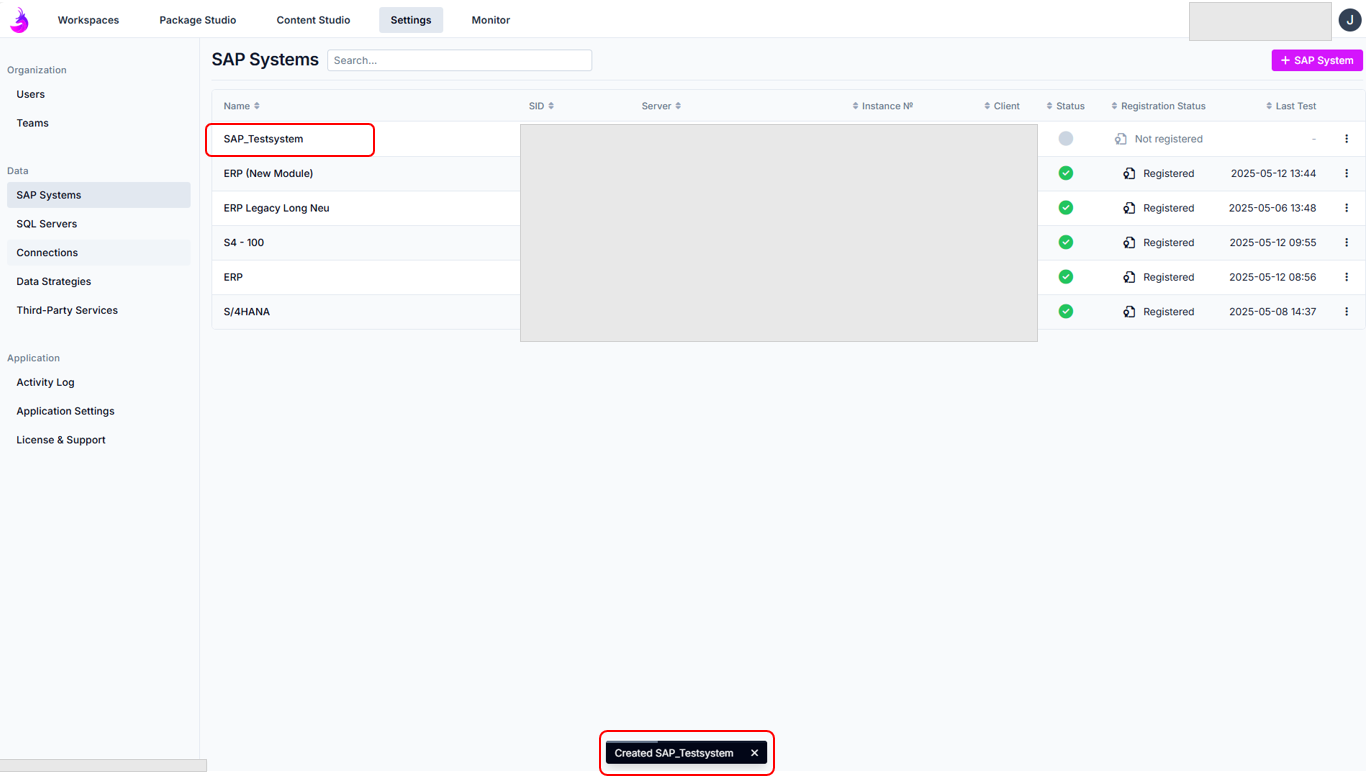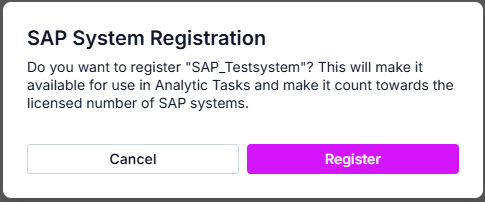SAP-System
Um ein SAP-System in dab Nexus hinzuzufügen, klicke oben auf Settings > SAP Systems und dann auf + SAP System.
Folgend musst Du einige Einstellungen hinterlegen:

- Name für die SAP-Verbindung vergeben
- Communication Type
Hier hast Du die Möglichkeit entweder einen RFC Function Call oder eine HTTP Request zu hinterlegen. Beide Optionen werden in diesem Artikel erklärt.
Folgende Einstellungen hast Du bei HTTP Request:

A Payload Format: Wahl zwischen Web Service und Process Integration, Endpiont URL, ggf. Aktivierung der Checkbox Is S/4HANA, wenn Dein SAP-System ein S/4HANA-System ist
B Authentication: Zusätzlich zur bereits bekannten Option Username and Password kannst Du die Option Client Certificate and Password hinzufügen.
- Client Certificate and Password (ersichtlich im nächsten Screenshot)
- Client: Mandant
- Language: Anmeldesprache
- Certificate: Zertifikat laden
- Password
- Server Type
- Application Server: System ID, Application Server, Instance Number, optional SAProuter und ggf. Aktivierung der Checkbox Is S/4HANA (falls Dein SAP-System ein S/4HANA-System ist)
- Load Balancing: System ID, Message Server, Group, optional SAProuter und ggf. Aktivierung der Checkbox Is S/4HANA (falls Dein SAP-System ein S/4HANA-System ist)
- Authentication: Anmeldung am SAP-System
- Username and Password
- Client: Mandant
- Language: Anmeldesprache
- Username
- Password
- SNC with SSO
- Client: Mandant
- Language: Anmeldesprache
- My Name (optional)
- Partner Name: den Partnernamen findest Du in der Transaktion SU01 des entsprechenden Benutzers - wähle die Registerkarte SNC, im Feld SNC-Name siehst du den Wert, den du als Partnernamen eintragen musst
- Quality of Protection: Wahl zwischen Authentication, Integrity, Privacy und Maximum Available
- Mechanism: Informationen findest Du im SAP Logon - klicke mit der rechten Maustaste auf die gewünschte Verbindung und wähle Eigenschaften und wechsle zum Reiter Netzwerk, wo Du diese Informationen findest.
- Kerberos und NTLM: falls nicht verfügbar, wähle Individual (ermöglicht Dir die Eingabe von SNC Library Path and My Name)
- SNC without SSO
- Client: Mandant
- Language: Anmeldesprache
- Username
- Password
- Partner Name: den Partnernamen findest Du in der Transaktion SU01 des entsprechenden Benutzers - wähle die Registerkarte SNC, im Feld SNC-Name siehst du den Wert, den du als Partnernamen eintragen musst
- My Name (optional)
- Quality of Protection: Wahl zwischen Authentication, Integrity, Privacy und Maximum Available
- Mechanism: Informationen findest Du im SAP Logon - klicke mit der rechten Maustaste auf die gewünschte Verbindung und wähle Eigenschaften und wechsle zum Reiter Netzwerk, wo Du diese Informationen findest
- Kerberos und NTLM: Falls nicht verfügbar, wähle Individual (ermöglicht Dir die Eingabe von SNC Library Path and My Name)
- RFC Configuration
- Certified: SAP-zertifizierter Funktionsbaustein
- Legacy (Extended): neuere Version des auf Z_RFC_READ_TABLE basierenden Funktionsbausteins mit Unterstützung für bis zu 8000 Zeichen pro Datensatz
- Legacy (Small): kleinere Version des auf Z_RFC_READ_TABLE basierender Legacy-Funktionsbaustein mit Begrenzung auf 2000 Zeichen pro Datensatz
- Funktionsbaustein
- /DABEXP/RFC_SAPCONNECTOR: Default, neuester Funktionsbaustein
- Z_RFC_READ_TABLE: alte Version des Funktionsbausteins
- Custom: Name muss rechts daneben eingegeben werden, falls der Funktionsbaustein umbenannt wurde

Limit dependency batch size und die Erhöhung der Anzahl der System Slots kann zu Performance-Problemen in Deinem SAP-System führen.
- System Slots: Anzahl der maximal möglichen, gleichzeitigen Verbindungen zu diesem SAP-System (Standard: 2 Slots)
- Available Data Masking: definiere, welche Maskierungsoptionen bei der Task-Erstellung verfügbar sind
- Batch Size: lege fest, wie viele Zeilen maximal pro Anfrage aus dem SAP-System extrahiert werden (Standard: 15.000)
- Dynamic batch size: versucht, anhand der gesetzten Batch Size und der Spaltenauswahl der Tabelle die Zeilen-Extraction zu optimieren
- Limit dependency batch size: wenn Dein SAP-System MaxDB nutzt und Du Probleme bei der Daten-Extraction hast, kannst Du diese Option aktivieren
- Test download table (optional): hier kannst Du eine Tabelle hinterlegen, mit welcher der Verbindungstest durchgeführt wird (Standard: T000, Fallback: T001)

- General / Permissions: wechsle zwischen den Tabs für die Anmeldeinformationen und die Berechtigungen, wer diese Verbindung später verwenden kann
Wählst Du im Bereich Permissions nun Teams oder Einzelbenutzer aus, haben nur diese Teams bzw. Benutzer später Zugriff auf diese SAP-Verbindung. Wählst Du hier kein Team und keine Benutzer aus, haben alle Zugriff auf diese Verbindung.
- Test Connection (die Verbindung zum SAP-System kann auch ohne Verbindungstest gespeichert werden)
- Teste, ob dab Nexus mit den hinterlegten Einstellungen Dein SAP-System erreichen kann
- Es erscheint eine Erfolgsmeldung oder eine Fehlermeldung
- Create bzw. Create & Close: sobald alle Einstellungen hinterlegt sind, können die Verbindungsdaten zum SAP-System gespeichert werden. Mit Create & Close werden die Verbindungsdaten gespeichert, automatisch die Ansicht verlassen und zur Auflistung der hinterlegten SAP-Systeme zurückgekehrt
Nach erfolgreicher Erstellung der SAP-Verbindung erhältst Du eine Erfolgsmeldung und die neue Verbindung ist nun zusammen mit all deinen anderen SAP-Verbindungen in einem Tabellenformat verfügbar. Folgende Einzelheiten sind zu sehen:

- Name der Verbindung zum SAP-system, SID, Server, Instance number, Client, Status (Unknown, Connected, Failed), Registration Status und Last test.
Ohne eine erfolgreiche Verbindung und Registrierung kann das hier hinterlegte SAP-System nicht verwendet werden.

- drei Punkte neben dem Verbindungsnamen: hier kann die Verbindung getestet, registriert, geändert, kopiert, gelöscht und eine Änderungs-Historie angezeigt werden.
Sobald ein SAP-System in Deinem dab Nexus registriert wurde, belegt es einen Platz in der Lizenz. Die Anzahl der möglichen, registrierten SAP-Systeme kann in Settings > License & Support im Bereich SAP Configuration gefunden werden. Hier wird angezeigt, wie viele SAP-Systeme bereits registriert sind und wie viele maximal registriert werden können.


- Indikator, ob das SAP-System registriert ist oder nicht:
- Grau bzw. Not registered: SAP-System nicht registriert
- Schwarz bzw. Registered: SAP-System ist registriert (die Option Register im Untermenü wird grau)

